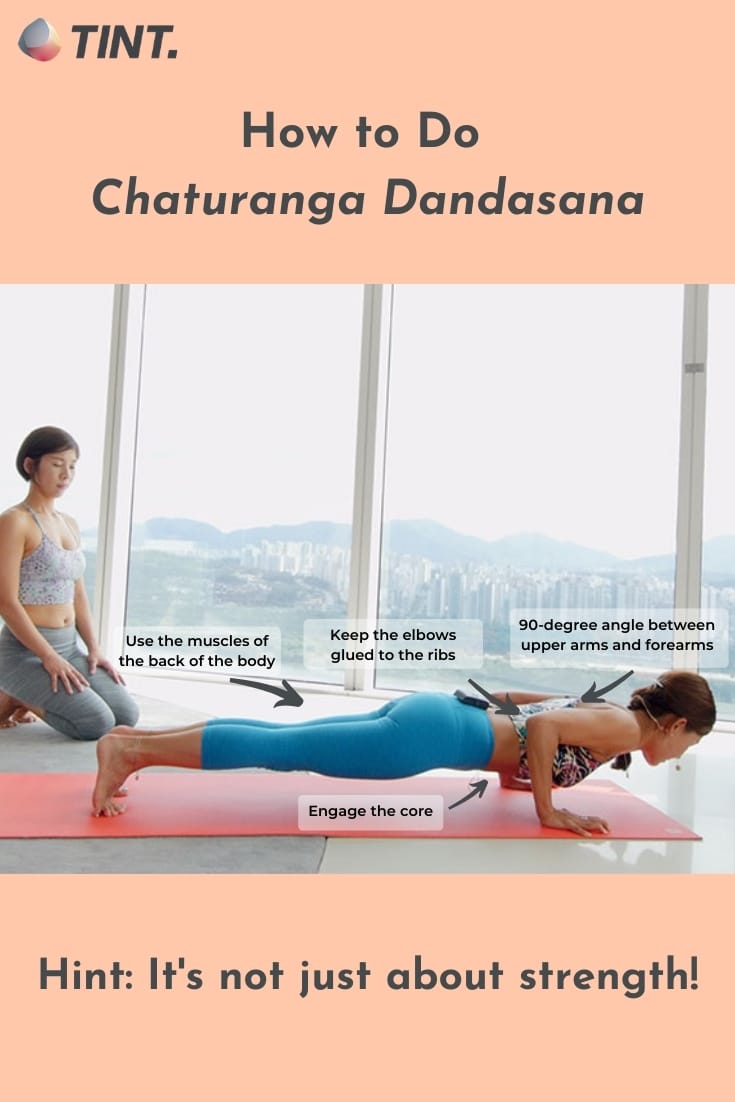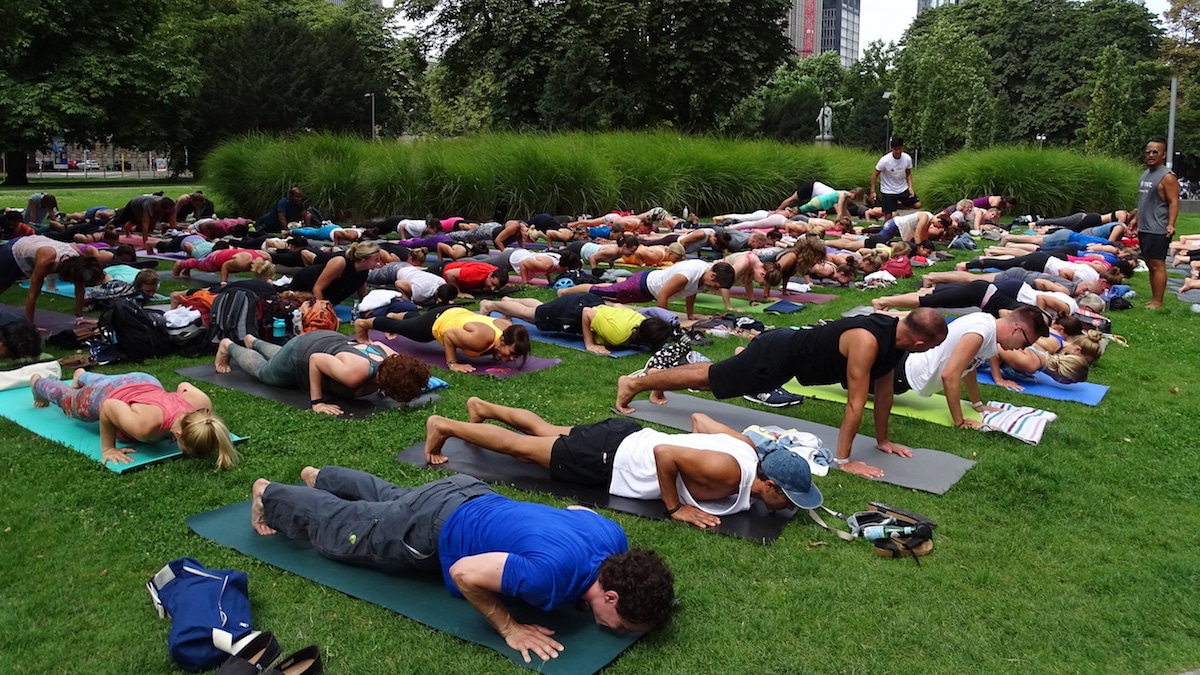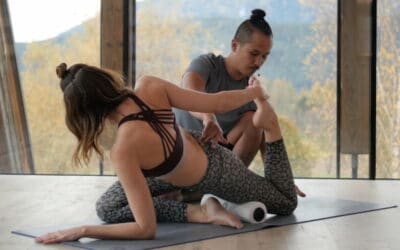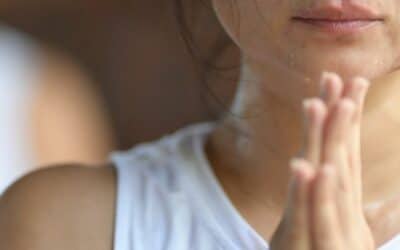The meaning of the Sanskrit term Chaturanga Dandasana is four-limbed staff pose – and that is a pretty good description of this yoga pose. When Chaturanga, also known as low plank, is performed correctly, the body resembles staff, with the spine in one straight line.
This yoga pose is an integral part of Vinyasa-style practices such as Sun Salutations. As such, it can serve as a powerful strength-builder for the arms, core, and the entire upper body. However, practicing Chaturanga with improper alignment may put you at risk for shoulder pain or injuries. Read on to find out how to align your body properly in this asana.
Learn how to do Chaturanga :
1. What Is the Proper Chaturanga Technique?
Practice the proper Chaturanga Technique in Alexey Gaevskij’s Functional Body workshop on TINT.
1.1. How to do Chaturanga Step by Step
- Start in High Plank with the shoulders slightly ahead of the wrists.
- Come onto the balls of the feet and push the heels back. Imagine you want to push a wall behind you away. This engages the quadriceps.
- Draw your chest forward to create a straight line from the crown of the head to the heels.
- Inhale and draw the shoulders and the tops of the thighs away from the floor.
- Pull the navel to the spine to engage the core.
- With the next exhalation, start bending the elbows and pull them in.
- Shift forward onto the toes to move the torso forward so that the shoulders come further forward.
- Slowly lower yourself toward the floor with control until the shoulders are at the same level as the elbows. Keep the elbows glued to your ribs and the body as straight as a staff (hence the name!).
- Avoid dropping your belly down or sticking the sitting bones up.
1.2. Chaturanga Right & Wrong
First of all, aim at maintaining a 90-degree angle between the upper arms and the forearms. This will also ensure that the upper arms are parallel to the floor.
Secondly, focus on keeping the elbows close to the body when lowering down. Imagine they’re glued to your ribcage. Remember that Chaturanga Dandasana is not (!) a wide-armed pushup. The elbows should rather bend backward instead of pointing out toward the sides of the yoga mat.
Engage the core muscles by sucking the belly button in toward the spine and tuck the tailbone to lengthen the lower spine.
Also, use the muscles of the back of the body, i.e. the muscles around the spine and the shoulder blades as well as the triceps, hamstrings, and calf muscles.
On the other hand, do not force your body into Chaturanga yoga pose by using strength only. Avoid letting the shoulders drop below the elbows and do not let the elbows stick out to the sides. Neither should you let the hips sink down or let the buttock stick up.

Learn how to do Chaturanga step by step. Photo: TINT instructor Shaila Yoon.
2. What Is Your Body Doing In Chaturanga?
2.1. What Are the Joints Doing?
As the name suggests, the spine should be aligned like a staff, i.e. neutral.
In the upper body, the scapulae (shoulder blades) are abducted and the elbows are flexed. There’s pronation of the forearms and the wrists are in dorsiflexion.
In the lower body, the hip is neutrally extended and adducted. The knees are extended and the ankles are in dorsiflexion.
2.2. Which Muscles Are Engaged?
In Chaturanga, the spinal extensors and flexors have the very important job of maintaining the neutral alignment of the spine. They therefore have to alternate between concentric and eccentric contraction.
Let’s take a look at the muscular actions in the upper body:
The serratus anterior contracts concentrically to prevent the shoulder blades from falling out. The rotator cuff muscles and the deltoids are responsible for stabilizing and protecting the shoulder joints. The pronator quadratus and teres effect the pronation of the forearm. The intrinsic muscles of the wrists and hands help to maintain the stability of the hand.
The pectoralis major and minor contract eccentrically to protect the shoulder joint against the pull of gravity.
Let’s move down to the lower parts of the body:
The hamstring, the adductor magnus and the gluteus maximus are responsible for maintaining the neutral extension and adduction of the hip. The articularis genu and vastii extend the knee and the tibialis anterior effects the dorsiflexion of the ankles. The intrinsic and extrinsic foot muscles support the weight of the legs on the toes.
For more tips on proper alignment in some of the most common yoga poses, check out our free asana ebook. You’ll find step-by-step instructions, alignment quick-fixes and sequencing tips. Simply download it here and use it as your reference guide on the go.
3. How to Build Strength for Chaturanga?
3.1. What if you feel you’re too weak for Chaturanga?
In this yoga pose, weakness in the lower body can be particularly dangerous as this may become apparent in hyperextension in the lumbar spine combined with hip flexion. To prevent this, it’s important to engage the hamstrings so that the hip is extended.
If the upper body is too weak for Chaturanga, especially the triceps brachii and the serratus anterior are concerned, which can lead to downward rotation of the shoulder blades and result in overusing the pectoralis major and minor.
You may feel stronger in the back when you pull the shoulder blades down by engaging the latissimus dorsi, but this can even aggravate the hyperextension of the lower back and the downward rotation of the shoulder blades.
It’s important to note here that the shoulder joint is only supported by muscles and tendons. Therefore, weakness in the muscles can even lead to shoulder pain in Chaturanga or – in the worst case – you may even have a shoulder injury from Chaturanga, such as shoulder impingement. This shows that Chaturanga Dandasana does not only require strength, but also proper body alignment and coordination. This makes it a quite challenging yoga pose – especially for beginners. Here are some tips on how to build strength for Chaturanga.

Chaturanga requires a lot of strength – but not only that. Photo: TINT instructors Young Ho Kim and Alexey Gaevskij.
3.2. Keep the Knees on the Floor in Chaturanga
Since proper alignment is more important for a healthy and efficient yoga practice, you should never force your body into a low plank pose. Especially not, if you don’t have the core and upper-body strength (yet!) to keep the spine aligned and the elbows in line with the wrists. Therefore, it’s no shame at all to place the knees on the floor before you lower the body down.
3.3. Practice Chaturanga Against a Wall
You can also build strength for Chaturanga by practicing the yoga pose against a wall. This will help you get a feeling for the correct arm position. Stand in front of a wall facing it. Place the hands against the wall so that the forearms are parallel to the floor. Bend the elbows and keep the wrists flexed, i.e. the fingertips point toward the ceiling. Also practice engaging the core here by pulling the navel in. Tuck the tailbone and tilt the pelvis slightly back to lengthen the lower spine.
3.4. Practice Alternatives to Chaturanga
While you’re still building strength for Chaturanga, you can also substitute this pose with alternatives such as knees-chest-chin pose (Ashtanga Namaskara). Simply lower the knees onto the ground when you’re in Plank pose. However, remember to keep the core engaged as you lower down. This time, you also place the chest and chin on the floor so that the buttocks stick out. Also, keep the shoulders away from the floor and broaden the collarbones to open the chest.
Another alternative to Chaturanga is High Plank (Kumbhakasana or Phalakasana). This means, if you still feel your arms are too weak for Chaturanga, you can keep the arms straight before attempting the full pose.

Adjust Chaturanga to your practice. Photo: TINT instructors Young Ho Kim and Ami Norton.
4. How Can You Build Chaturanga into Your Yoga Practice?
Especially in Vinyasa yoga practices, Chaturanga Daṇḍasana is an integral part of the Sun Salutations (Surya Namaskar). It’s usually performed on an exhale and, depending on the Sun Salutation variation you’re practicing, repeated several times in one set. It’s usually practiced after Downward-Facing Dog or Plank pose, and followed by either Cobra or Upward-Facing Dog.
In other yoga styles that are more alignment-focused, such as Hatha yoga, Chaturanga may simply be held for a certain period of time with continuous breath.
4.1. Can You Do Sun Salutations Without Chaturanga?
If you don’t feel ready or too weak for Chaturanga, don’t worry. There are a few options for you to practice Sun Salutations without Chaturanga. You could, for example, place the knees on the ground for a Half Chaturanga. Another option is to even place the chest and the chin onto the yoga mat as you lower down. In some forms of Surya Namaskar, High Plank is used instead.
Practice a few rounds of Sun Salutations with David Lurey and Mirjam Wagner to try some alternatives to Chaturanga.
4.2. Are There More Challenging Alternatives to Chaturanga?
If you want to challenge yourself in Chaturanga Dandasana, you can put a bolster or a folded blanket underneath your body when you’re in High Plank. As you start bending your arms to lower down, stay in a position where your body slightly hovers above the prop or blanket.
Another option to spice up your yoga practice is transitioning into Chaturanga from Three-Legged Dog, i.e. with one leg lifted in the air. Keep the leg lifted as you move Three-Legged Plank Pose, and subsequently into Three-Legged Chaturanga. You can even continue with the same leg in the air when continuing into Three-Legged Upward-Facing Dog, and back into Three-Legged Downward-Facing Dog.
Well, and if that’s still not challenging enough for you, you can work on holding Chaturanga for an extra breath or two (or more!) to build even more strength. Or you can simply add a few extra rounds of Chaturanga into your yoga practice.
If you’re looking for guidance in other yoga arm balances, such as Side Crow or Crow pose, check out our free yoga asana eBook that takes you through ten of the most commonly practiced yoga poses. Download it for free and use it as a reference guide for your yoga practice.
5. What Are the Benefits of Chaturanga?
This yoga pose is a great workout for the arms and the entire upper body. It does not only help to tone the upper arm and forearm muscles but also to develop flexibility and strength in the wrists and hands.
Chaturanga also teaches you to stabilize your core muscles, thereby toning abdominal muscles. It strengthens the arms, shoulders, abdomen and back muscles and, thus, can improve your overall posture.
Apart from that, it can improve your sense of balance.
As such, this low plank pose is a great preparation for more challenging arm balances such as Crow or Side Crow. Chaturanga is often referred to as the mother of arm balances.
Practice arm balances with TINT. Start, for example, with Matt Giordano‘s Essentials of Arm Balances and work yourself up step by step to Master Your Crow with Mathieu Boldron. As a next step, you can even try to Master Your Twisting Arm Balances. If you’re up for a little challenge, try the Firefly Crow Fusion in Alexandra Harfield‘s Dips, Binds & Balances.
Since Chaturanga is the mother of arm balances, you can approach them after you’ve mastered this yoga pose. Try, for example, Matt Giordano’s Essentials of Arm Balances.
Since Chaturanga Dandasana also is an integral part of Vinyasa Yoga styles, you can practice it by flowing through some dynamic and energizing Vinyasa sessions on TINT such as Kristin McGee‘s Yoga Flow or Kat Fowler‘s workshop Revive. If you’re up for even more dynamic and energy, try Inside Flow – there’s a wide variety of classes on TINT!






